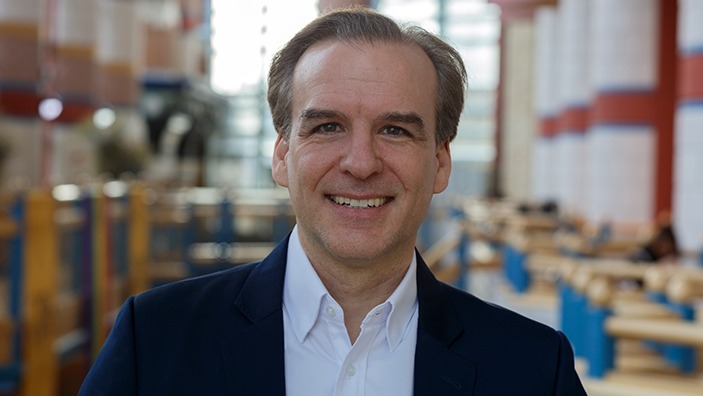At the time when blood-testing company Theranos was valued at $9 billion at its peak, CEO Elizabeth Holmes was heroically portrayed on magazine covers, in her trademark black turtleneck, as a charismatic and pioneering leader who inspired awe from her employees. The company collapsed in 2018 when it was disclosed that the firm’s supposedly revolutionary technology simply didn’t work, and Holmes was sent to prison for defrauding investors.
A leader’s ability to inspire awe can, to be sure, help a company reach new heights through loyalty and determination to reach new frontiers, and the development of the iPhone by Apple under CEO Steve Jobs is frequently cited as such an example. Yet awe and charisma can also have negative consequences for businesses and for society more broadly, as evidenced by the Theranos saga and other CEO downfalls such as Adam Neumann of WeWork who resigned under investor pressure.
Awe and charisma have been the subjects of numerous studies at Cambridge Judge Business School, as have related topics surrounding leadership hubris, and their findings have been featured in some of the top academic journals and business publications. So what are the takeaways from this research?
The science behind awe: a new model for understanding charismatic leaders
Jochen Menges, Professor of Leadership at Cambridge Judge and the University of Zurich, has been at the forefront of research in this area. In a study he co-authored with academics based in the US and Singapore, Jochen and colleagues identified a lack of systematic research on the nature of awe and effects of awe in leadership within organisational contexts. So they developed a conceptual framework to explain the complex and transformative nature of leadership through the power of awe – whether for good or bad.

“Throughout the annals of history, leaders have inspired social unity and evoked intense emotions among their followers,” says the research published in the Academy of Management Review. “Whether political figures, business leaders, social activists or religious zealots, these leaders have used this ability to inspire to great effect, bringing people together and effecting significant social change. The consequences of such leaders, however, have been remarkably varied. For example, whereas Martin Luther King Jr catalysed a social movement through his inspirational vision of a more just society, Benito Mussolini used his similarly charismatic rhetoric to unite his followers, leading to mass support for his fascist regime.”
Most psychological research on how awe is experienced in non-organisational contexts concerns exposure to nature such as witnessing the grandeur of the Northern Lights, standing at the edge of the Grand Canyon, or walking through the misty peaks of the Scottish Highlands. Awe may have inspired countless literary and artistic works such as William Wordsworth’s poem I Wandered Lonely As A Cloud (with its “host of golden daffodils”) and John Denver’s song Take Me Home, Country Roads (to “Almost heaven, West Virginia”, where “Life is old there, older than the trees, younger than the mountains, growing like a breeze”). Such towering yet flowery sentiment has carried over into organisational research, and this has mostly focused on the positive psychological effects – reflecting an affinity with nature and a corresponding sense of oneness with humanity as a whole.
“Our research argues that these benevolent aspects of awe are valuable and may indeed be uplifting, but there are big open questions about how we understand the many types of leaders who inspire awe in their followers, and the multifaceted effects of awe in social contexts,” says the study by Jochen. “Some effects may be very beneficial to organisations and individuals, but others may also produce a cult of personality, a loss of critical thinking, or an in-group identification that could be detrimental. Our research aims to provide a far fuller understanding of awe.”
The conceptual framework developed in Jochen’s research identifies 4 leader behaviours that elicit awe among followers. It also identifies 3 variants of awe-inspiring leaders and how these variations orient followers toward different reactions. The research argues further that a leader’s zero-sum beliefs either intensify or weaken these behavioural consequences. So let’s dig deeper.
Our research argues that these benevolent aspects of awe are valuable and may indeed be uplifting, but there are big open questions about how we understand the many types of leaders who inspire awe in their followers, and the multifaceted effects of awe in social contexts.
Charisma in action: from sacrifice to storytelling
The 4 leader behaviours identified in the framework research are:
1
Charismatic leadership tactics
Charisma can fill followers with adoration in addition to awe, and it can positively change followers in ways that increase their prosocial, team-oriented behaviour and a shared sense of purpose. Such tactics include verbal or rhetorical techniques (including the use of anecdotes, metaphors, contrasts and communicating confidence that expectations can be met), as well as nonverbal tactics such as body gestures and facial expressions.
2
Exceptional performance
A demonstration of exceptional performance through objective and observable benchmarks such as sales records or industry awards inspires awe through conveying high standards and enhancing a leader’s influence. One aspect of such performance elicits “how did they do it?” queries, says the research, noting that Warren Buffett’s investment performance over decades at Berkshire Hathaway made him one of the world’s most revered investors.
3
Problem reframing
Leaders can inspire awe through presenting challenges and issues in novel and thought-provoking ways that shift contexts, connect a matter to different objectives or uncover new relationships, thus opening up avenues for new solutions by challenging conventional assumptions. “Indeed, leadership is a language game that relies heavily on the ability to reframe problems and challenges,” says the research. “Just as epiphanies and revelations have been theorised to promote awe, we suggest that leaders provide the impetus for followers to experience this themselves through problem reframing.”
4
Self-sacrificial behaviour
Leaders can foster follower experiences of awe through morally virtuous actions that include putting the needs of a group above one’s own needs and publicly admitting error. Yet while self-sacrificial behaviour can suggest selflessness to followers, the authors note that self-interested or narcissistic leaders might use self-sacrificial behaviour to reap benefits by “strategically promoting the image of a martyr”.
From Steve Jobs to Anita Roddick: understanding different charisma styles
The 3 types of awe-inspiring leader delineated in the framework influences their identification with larger social entities, which include the leader, a part of the organisation (often an “in-group”), or humanity broadly. “As the ‘I’ becomes smaller, the ‘we’ becomes bigger,” says the research.
These 3 variants of awe-inspiring leaders are:
1
Independent
Independent leaders who typically direct attention toward themselves and the critical and autonomous role they serve within an organisation, such as Steve Jobs, who often “view themselves as distinct from others, often garner fascination and interest from followers who come to idolise and personally identify with them”. While this can accomplish great things, such leaders are “likely to be assertive and report greater levels of Machiavellianism and narcissism”, and can inadvertently reduce collaborative efforts while underemphasising group aspects that are key for social cohesion within an organisation.
2
Collective-interdependent
Collective-interdependent leaders who primarily think of themselves as belonging to a group, and thus typically consult other stakeholders rather than deciding unilaterally on a plan of action. “Possessing a collective-interdependent self-construal goes beyond merely being committed or loyal to a group; it signifies deeper integration whereby the boundaries between the individual’s self-definition and the group become permeable,” says the research.
3
Humanity identification
Some awe-inspiring leaders “evoke a deep sense of connection to all of humanity rather than a specific group”, says the research, citing The Body Shop founder Anita Roddick and her commitment to fair trade and addressing issues of economic equality. “Leaders holding a humanity self-construal are less likely to define themselves in relation to particularistic social groups, such as race, nationality, ideology, or an organisation. Instead, their self-construal is largely defined by human connectedness, fostering a culture of inclusion, tolerance, and global responsibility.”
The dark side of hero worship: conformity and fear of dissent
Jochen and colleagues dig deeply into the issue of hero worship, or “excessive admiration for and idealisation of a leader”, which can evoke loyalty, hard work and determination among followers to reach the leader’s goal, but may also “produce uncritical acceptance of the leader’s ideology, conformity, loss of critical thinking, fear of dissent, and in extreme cases, even the willingness to commit violent acts”.
Together, these behaviours and types of leaders form a framework that Jochen and his co-authors promote as a way for organisations to make sense of charisma, leadership and awe, concluding that “it is incumbent upon leaders to be aware that awe presents a double-edged sword because it elicits narrow social identities in followers”.
It is incumbent upon leaders to be aware that awe presents a double-edged sword because it elicits narrow social identities in followers.
How employees deal with emotions regarding charismatic leaders
Jochen’s previous research includes a study on how employees deal with their emotions when encountering a charismatic leader. “Followers under the influence of leaders’ charisma tend to suppress the expression of emotions (we call this the “awestruck effect”), but followers express emotions when leaders consider them individually. Awestruck followers may suffer from expressive inhibition even as charismatic leaders stir their hearts,” says the research published in the journal Leadership Quarterly.
That study outlines practical implications of the findings for both leaders and followers:
- leaders need to switch between a charismatic and an individually considerate leadership style, depending on the task at hand
- when using a charismatic style, leaders should be aware of their emotionally suppressive effect on followers – it gives the leader an opportunity to exude influence but may also prevent followers from showing how they truly feel
- when using an individually considerate style, leaders should recognise that they have an encouraging effect on followers’ emotion expression – it puts the leader in listening mode and allows them to gather information and genuine feedback
Followers, in turn, should beware of the emotionally suppressive effects of charismatic leaders. It may feel good to be dazzled by a charismatic leader, but it may also risk that followers overlook darker sides of the leader.
“For business leaders, offering individualised consideration of followers or temporarily reducing their own status may be vital ways that followers can show their emotions,” says Jochen. “Emotion suppression can work in the moment, but over time it is not helpful to the individuals involved or the organisation, because it can inhibit employees from fully engaging at work and tends to wear them out.”
Emotion suppression can work in the moment, but over time it is not helpful to the individuals involved or the organisation, because it can inhibit employees from fully engaging at work and tends to wear them out.
How awe became a focal topic in leadership research
Jochen traces his interest in awe and charismatic leadership back to a moment in Berlin in 2008, when he joined thousands to hear the then-presidential contender from the US, Barack Obama, speak. Jochen was a doctoral student at the time, studying leadership and emotions. He attended the speech to see leadership in action, and remembers being struck by the emotional atmosphere the speech generated – the collective awe stirred by Obama’s presence.
This early insight became the spark for a deeper inquiry. After completing his PhD, Jochen moved to Cambridge, where awe revealed itself in a different form. The University’s centuries-old architecture, academic gravitas, and quiet grandeur inspired him to explore awe not just as a fleeting feeling, but as a force that shapes how people think, behave and lead.
Jochen soon discovered that while awe can motivate and unite, it can also cloud judgment – making people more susceptible to influence. “When you turn on the news, you’re often exposed to awe-inducing moments – for better or worse. Leaders around the world clearly understand the power of awe.” Yet despite its power, awe remains difficult to study in experimental settings, which may explain why it has received little attention in leadership research. “Science is only now catching up.”
Broader implications for HR and strategy: narcissism, power and the personality of leaders
Other Cambridge Judge researchers have also looked at issues relating to personality and leadership, particularly narcissism and hubris.
The late Cambridge Judge Professor Sucheta Nadkarni looked at how personality – particularly narcissism and extraversion – affect leaders’ corporate strategies. In a 2018 study, she found that narcissistic CEOs with liberal ideologies were more effective in promoting corporate social responsibility (CSR) initiatives, while, in contrast, narcissism did not enhance the ability of conservative CEOs to implement downsizing strategies. In a supplementary study, the authors found that narcissism “relates strongly to individuals’ inflated perception of their discretion, whereas extraversion relates to their ability to sell an issue to others”.
The research published in the journal Administrative Science Quarterly sheds light on why some CEOs can effectively align their strategies with their political ideologies and others fail to do so, by focusing on personality traits as key sources of managerial discretion in “enabling or inhibiting the infusion of their ideologies into strategic behaviours”. The authors said the findings were an important step in reconciling previous equivocal findings on the role of CEO ideology in driving company strategy.
Hubris and overconfidence on the part of leaders has also been researched at Cambridge Judge, and was the focus of a conference on how an enhanced sense of power can distort perception and decision-making to firms’ detriment.
Christoph Loch, Professor of Operations and Technology Management and former Director (Dean) of Cambridge Judge, wrote a chapter on hubris in a book entitled The Intoxication of Power. He argues that hubris is the “tail end of a normal psychological trait, narcissism and status seeking, rather than a medical syndrome”. But hubris, like all biological traits, are subject to nature-and-nurture variation that makes some people more prone to narcissism, and powerful roles make people more vulnerable to developing hubris.
“If dysfunctional hubris is an extreme level of a trait that we all have, then correcting hubristic behaviour becomes an issue not of eliminating a pathology, but of reducing the extreme expression of a general tendency,” he writes, arguing that individuals can reduce hubris and its negative effects in ourselves through both our personal attitudes and how we conceptualise the functions and privileges of leadership.
A mismatch between leadership model and needs of followers

In a 2020 study in The Leadership Quarterly, Christoph says that one reason the charismatic leadership model of leadership often fails is likely due to a mismatch between the needs of the followers (organisation or a society) and the design features of that particular leadership model. “The mismatch is likely to arise when one fails to ask a fundamental question: what was the model designed to deliver? Is charisma required for its own sake, or are leaders performing the functions that are needed by the followers?”
In so focusing on the needs of the followers, the experimental study holds practical implications for how leaders should focus not on charisma but on co-ordination and conflict resolution. “This is a more humble view of leadership: it describes a role that many more people could be capable of achieving than the ‘heroic’ leader role that requires producing a vision, absorbing pressure and motivating by good example, while simultaneously suppressing rivals with Machiavellian alliances. Leadership is about co-creating common good. This humble role requires very different skills from the leader, essentially skills of diplomacy.”
Christoph acknowledges that shrinking violets generally don’t get to the CEO’s corner office, as “competition for the alpha position requires a hyperactive competitive game that leader hopefuls have to play in order to beat rivals”, and he suggests there may be a weakness in organisations’ human resources systems that are designed to identify and reward leadership potential.
“The role of the leader once he or she gets there must be inclusive and oriented toward the group, and maybe it is less exclusive and more achievable by dedicated and well-meaning normal people than leadership literature suggests: maybe many people are capable of helping a group to co-ordinate and resolve conflicts, and therefore many people can be useful leaders.”
Physical settings and leadership presence: more than just a stage
The corner office is prestigious, surely, but leaders operate in all sorts of settings – ranging from speeches in conference halls to touring a factory to boardroom strategising. Yet charisma is usually attributed to CEOs and other leaders based on how they look, talk and carry themselves – their own presence, not the environment within which they lead. So how does the physical environment influence the attribution of leader charisma? That aspect had been little understood prior to another study co-authored by Jochen Menges.
The research noted that leaders occupy physical spaces that vary across contexts. In a series of experiments, it found that grandeur in the physical environment, compared to an ordinary setting, can enhance the attribution of charisma for leaders – but this effect is diminished or absent for leaders already known for their charisma.
Participants in the study were randomly assigned to either a known charismatic leader or a leader who was relatively unknown, and were presented with a series of pictures showing each leader in awe-inducing backgrounds (such as mountains, nature, large buildings and city overviews) or ordinary backgrounds (such as plain walls) – and participants are then asked to attribute levels of charisma to each leader.
The practical implication of the study is that organisations can benefit from designing physical workplace environments in ways that promote feelings of awe, because this can facilitate a leader’s ability to influence followers toward the attainment of organisational goals – particularly when leaders need to unite teams to pursue a new strategic organisational vision. The research may also imply that holding organisational get-away events in inspirational settings such as mountains, lakeside venues or forests may have unique value that can justify the expense of such out-of-the-ordinary settings.
The benefits and dangers of awe need to be managed
Charisma and awe can elevate leadership, including driving innovation and unity of purpose, but they carry clear risks. Cambridge Judge research shows that the effect of awe-inspiring leaders can pivot on how such influence is exercised, so by identifying behaviours and leadership types that elicit awe, companies can take measures to unlock the positive impact while minimising the negatives.
True leadership isn’t just about commanding attention and admiration. The research suggests that it’s really about using influence ethically – fostering teamwork in a way that advances a firm’s goals and society’s collective good.
Featured faculty
Jochen Menges
Professor of Leadership
Christoph H Loch
Professor of Operations and Technology Management
Featured research
McGuire, J., McAllister, D.J., Menges, J.I. and De Cremer, D. (2025) “The power and peril of awe in leadership: transforming follower identity and behavior.” Academy of Management Review
Gupta, A., Nadkarni, S. and Mariam, M. (2018) “Dispositional sources of managerial discretion: CEO ideology, CEO personality, and firm strategies.” Administrative Science Quarterly
Ahmad, M.G. and Loch, C. (2020) “What do the followers want? The core functions of leadership.” The Leadership Quarterly
McGuire, J., Bastardoz, N., Hentrup, L.J., De Cremer, D. and Menges, J.I. (2024) “The backdrop of leadership: how environmental awe influences charisma attributions.” Journal of Organizational Behavior





